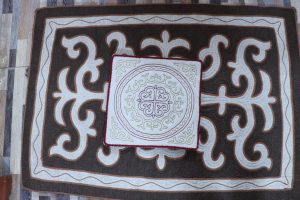




White felt (koshma) plays a significant role in the material world of the sacred space of Kazakh culture. As a rule, it correlates with the higher class of the Turkic society. The representatives of the white felt (aq süiek) sat exclusively on white felt mats during the general kurultais of the nomads, the special importance of the “aq kiiz” is shown in the rite of election of the khans. The ritual is described as follows: The four elders place the aspirant on a thin white carpet with gilded edges, raise him above their heads, and then lower him down. After removing his clothes, they tear them into pieces and distribute them to those present. The same is done with the koshma. Then the new khan is dressed in a new robe specially made for him to match his status. Semiologist A. A. Galiev sees several symbolic meanings in this process. First, the white felt mat symbolises the purity of the khan’s intentions; second, the square shape of the white felt mat projects the horizontal projection of the world; the four elders can be seen as a symbol of the four pillars on which the Kazakh world rests (the elder as the bearer of wisdom and knowledge); the gilded edges of the felt mat symbolise the khan’s power (since the Sak period, gold has been an attribute of royalty).
A koshma made of wool symbolised wealth, as did the khan’s clothes, which were coveted by those who participated in the elections. Here, everyone tried to get a garment or koshma, according to the principle of “pars pro toto”, even a rag could bring good luck to its owner [5, p.84].


